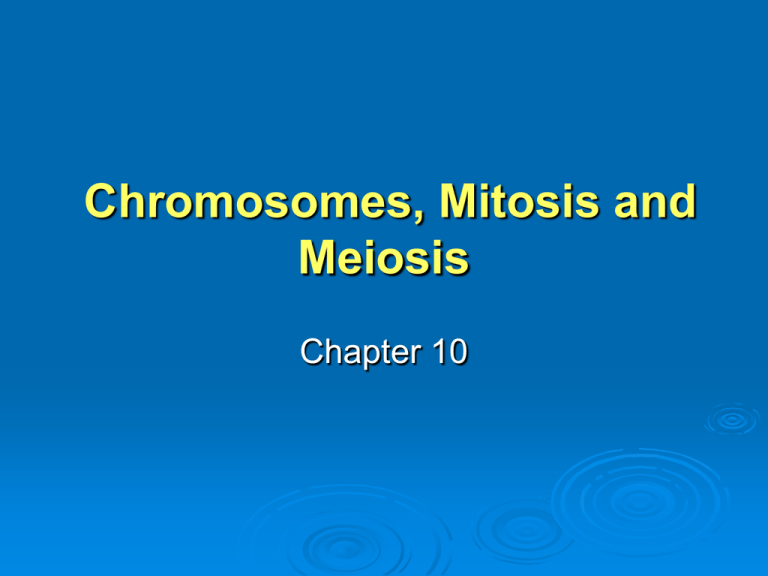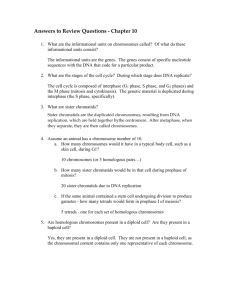homologous chromosomes
advertisement

Chromosomes, Mitosis and Meiosis Chapter 10 Learning Objective 1 • What is the significance of chromosomes in terms of information? Chromosomes Organization • Genes • • • Chromatin • • • cell’s informational units made of DNA DNA and protein makes up chromosomes (eukaryotes) Chromosomes • • allow DNA sorting into daughter cells KEY CONCEPTS • In eukaryotic cells, DNA is wound around specific proteins to form chromatin, which in turn is folded and packaged to make individual chromosomes Learning Objective 2 • How is DNA organized in prokaryotic and eukaryotic cells? Prokaryotic Cells • Contain circular DNA molecules Eukaryotic Chromosomes • Nucleosome • • • histone (protein) bead wrapped in DNA organized into coiled loops held together by nonhistone scaffolding proteins Nucleosomes DNA wound around a cluster of histone molecules Histone tails Linker DNA Nucleosome (10 nm diameter) Fig. 10-2a, p. 213 100 nm Fig. 10-2b, p. 213 Scaffolding Proteins DNA Scaffolding proteins 2 μm Fig. 10-3, p. 213 Chromosome Organization 1400 nm 700 nm 300 nm fiber (looped domains) 30 nm chromatin fiber DNA wound around a cluster of histone molecules Condensed Condensed Scaffolding chromosome chromatin protein Extended chromatin Packed nucleosomes Histone 10 nm 2 nm DNA double helix Nucleosomes Fig. 10-4, p. 214 Learning Objective 3 • What are the stages in the eukaryotic cell cycle, and their principal events? Eukaryotic Cell Cycle • Cycle of cell division • • interphase M phase INTERPHASE G1 (First gap phase) S (Synthesis phase) G2 (Second gap phase) M PHASE (Mitosis and cytokinesis) Fig. 10-5, p. 215 Interphase • First gap phase (G1 phase) • • Synthesis phase (S phase) • • • cell grows and prepares for S phase DNA and chromosome protein synthesis chromosome duplication Second gap phase (G2 phase) • • protein synthesis increases preparation for cell division M Phase • Mitosis • • • nuclear division two nuclei identical to parent nucleus Cytokinesis • • cytoplasm divides two daughter cells KEY CONCEPTS • Cell division is an important part of the cell cycle, which consists of the successive stages through which a cell passes Animation: The Cell Cycle CLICK TO PLAY Learning Objective 4 • What is the structure of a duplicated chromosome, including the sister chromatids, centromeres, and kinetochores? A Duplicated Chromosome • Consists of a pair of sister chromatids • • Centromere • • • containing identical DNA sequences constricted region joins sister chromatids Kinetochore • • protein to which microtubules bind attached to centromere Sister Chromatids Centromere region Microtubules Kinetochore Sister chromatids 1.0 μm Fig. 10-7, p. 218 Learning Objective 5 • What is the process and significance of mitosis? Mitosis • Preserves chromosome number • • in eukaryotic cell division Identical chromosomes are distributed to each pole of the cell • nuclear envelope forms around each set Interphase INTERPHASE Chromatin PROPHASE Nucleolus Nucleus Pieces of nuclear envelope PROMETAPHASE Sister chromatids of duplicated chromosome Spindle microtubule Nuclear envelope Centrioles Plasma membrane Kinetochore Developing mitotic spindle Fig. 10-6a, p. 216 Prophase • • • Chromatin condenses into duplicated chromosomes (pair of sister chromatids) Nuclear envelope begins to disappear Mitotic spindle begins to form Mitotic Spindle Metaphase plate (cell’s midplane) Kinetochore microtubule (spindle microtubule) Centrioles Astral microtubules Pericentriolar material Polar (nonkinetochore) microtubule Sister chromatids Fig. 10-9a, p. 219 10 μm Fig. 10-9b, p. 219 Prophase Prometaphase • • Spindle microtubules attach to kinetochores of chromosomes Chromosomes begin to move toward cell’s midplane Prometaphase Metaphase • • • Chromosomes align on cell’s midplane (metaphase plate) Mitotic spindle is complete Microtubules attach kinetochores of sister chromatids to opposite poles of cell Metaphase Anaphase • Sister chromatids separate • • move to opposite poles Each former chromatid is now a chromosome Anaphase Telophase • • • • • Nuclear envelope re-forms Nucleoli appear Chromosomes uncoil Spindle disappears Cytokinesis begins Telophase ANAPHASE TELOPHASE 25 μm METAPHASE Spindle Cleavage furrow Centriole pair at spindle pole Cell’s midplane (metaphase plate) Daughter chromosomes Reforming nuclear envelope Fig. 10-6b, p. 217 KEY CONCEPTS • In cell division by mitosis, duplicated chromosomes separate (split apart) and are evenly distributed into two daughter nuclei Cytokinesis Cleavage furrow Actomyosin contractile ring 10 μm Fig. 10-10a, p. 220 Vesicles gather on cell’s midplane Plasma Cell membrane wall Small vesicles fuse, forming larger vesicles Cell plate forming Eventually one large vesicle exists New cell walls (from vesicle contents) New plasma membranes (from vesicle membranes) Cell plate Nucleus forming 5 μm Fig. 10-10b, p. 220 Learning Objective 6 • How is the cell cycle controlled? Cell-Cycle Control • Cyclin-dependent kinases (Cdks) • • • protein kinases that control cell cycle active only when bound to cyclins Cyclins • • regulatory proteins levels fluctuate during cell cycle Cyclins 1 5 Cdk G1 1 2 1 Cyclin is synthesized and accumulates. 3 3 M-Cdk phosphorylates proteins, activating those that facilitate mitosis and inactivating those that inhibit mitosis. 4 An activated enzyme complex recognizes a specific amino acid sequence in cyclin and targets it for destruction. When cyclin is degraded, M-Cdk activity is terminated, and the cells formed by mitosis enter G1. 5 Cdk is not degraded but is recycled and reused. S 4 M G2 Cyclin 4 Degraded cyclin 5 2 Cdk associates with cyclin, forming a cyclin–Cdk complex, M-Cdk. 2 3 M-Cdk (triggers M phase) Cdk Fig. 10-12, p. 222 KEY CONCEPTS • An internal genetic program interacts with external signals to regulate the cell cycle Learning Objective 7 • What is the difference between asexual and sexual reproduction? Asexual Reproduction • Single parent • • offspring have identical hereditary traits Mitosis • basis for eukaryotic asexual reproduction Binary Fission Plasma membrane Cell wall Origin of replication Prokaryotic cell Bacterial DNA Two copies of bacterial DNA 1 DNA replication begins at single site on bacterial DNA. 2 Replication continues, as replication enzymes work in both directions from site where replication began. 3 Replication is completed. Cell begins to divide, as plasma membrane grows inward. 4 Binary fission is complete. Two identical prokaryotic cells result. Two identical prokaryotic cells Fig. 10-11, p. 221 Sexual Reproduction • • Two haploid sex cells (gametes) fuse to form a single diploid zygote Meiosis • produces gametes Learning Objective 8 • • What is the difference between haploid and diploid cells? What are homologous chromosomes? Diploid Cell • Chromosomes are paired (homologous chromosomes) • • similar in length, shape, other features carry genes affecting the same traits Haploid Cell • Contains only one member of each homologous chromosome pair Fig. 10-16, p. 229 MITOSIS PROPHASE No synapsis of homologous chromosomes ANAPHASE Sister chromatids move to opposite poles DAUGHTER CELLS Two 2n cells with unduplicated chromosomes Fig. 10-16a, p. 229 MEIOSIS PROPHASE I Synapsis of homologous chromosomes to form tetrads ANAPHASE I Homologous chromosomes move to opposite poles PROPHASE II Two n cells with duplicated chromosomes ANAPHASE II Sister chromatids move to opposite poles HAPLOID CELLS Four n cells with unduplicated chromosomes Fig. 10-16b, p. 229 Learning Objective 9 • What is the process and significance of meiosis? Meiosis • • One diploid cell divides two times, yielding four haploid cells Sexual life cycles in eukaryotes require meiosis • each gamete contains half the number of chromosomes in parent cell Meiosis I • Prophase I • • Crossing-over • • • homologous chromosomes join (synapsis) between homologous (nonsister) chromatids exchanges segments of DNA strands Results in genetic recombination Synapsis Maternal sister chromatids Paternal sister chromatids Synaptonemal complex Chromatin Protein Chromatin Maternal sister chromatids Fig. 10-14a, p. 228 Chromosome Synaptonemal complex Chromosome 0.5 μm Fig. 10-14b, p. 228 Meiosis I • Metaphase I • • Anaphase I • • • tetrads (homologous chromosomes joined by chiasmata) line up on metaphase plate homologous chromosomes separate distributed to different nuclei Each nucleus contains haploid number of chromosomes • each chromosome has 2 chromatids Tetrads and Chiasmata Sister chromatids Chiasmata Kinetochores Sister chromatids 1 μm Fig. 10-15a, p. 228 Sister chromatids Chiasmata Kinetochores Fig. 10-15b, p. 228 Meiosis II • Two chromatids of each chromosome separate • • one distributed to each daughter cell Each former chromatid is now a chromosome Meiosis Meiosis INTERPHASE MEIOSIS I Mid-prophase I Nucleolus Nuclear envelope Chromatin Centrioles Interphase preceding meiosis; DNA replicates. Late prophase I Homologous chromosomes Developing meiotic spindle Homologous chromosomes synapse, forming tetrads; nuclear envelope breaks down. Fig. 10-13a (1), p. 226 MEIOSIS II Prophase II Metaphase II Anaphase II Daughter chromosomes Chromosomes condense again following brief period of interkinesis. DNA does not replicate again. Chromosomes line up along cell's midplane. Sister chromatids separate, and chromosomes move to opposite poles. Fig. 10-13a (2), p. 226 Anaphase I Metaphase I Telophase I Microtubule attached to kinetochore Sister chromatids Tetrads line up on cell's midplane. Tetrads held together at chiasmata (sites of prior crossingover). Cleavage furrow Separation of homologous chromosomes Homologous chromosomes separate and move to opposite poles. Note that sister chromatids remain attached at their centromeres. One of each pair of homologous chromosomes is at each pole. Cytokinesis occurs. Fig. 10-13b (1), p. 227 Telophase II Four haploid cells 25 μm Nuclei form at opposite poles of each cell. Cytokinesis occurs. Four gametes (animal) or four spores (plant) are produced. Fig. 10-13b (2), p. 227 Learning Objective 10 • What are the different processes and outcomes of mitosis and meiosis? Mitosis • • • Single nuclear division 2 daughter cells genetically identical to each other and to original cell No synapsis of homologous chromosomes Mitosis Meiosis • • Two successive nuclear divisions form four haploid cells Synapsis of homologous chromosomes occurs during prophase I Meiosis KEY CONCEPTS • Meiosis, which reduces the number of chromosome sets from diploid to haploid, is necessary to maintain the normal chromosome number when two cells join during sexual reproduction KEY CONCEPTS • Meiosis helps to increase genetic variation among offspring Learning Objective 11 • Compare the roles of mitosis and meiosis in various generalized life cycles Animals • Somatic cells are diploid • • produced by mitosis Gametes are haploid • produced by meiosis (gametogenesis) Animal Life Cycle Gametes (n) Meiosis Fertilization Zygote (2n) Mitosis Multicellular diploid organism (2n) Animals Fig. 10-17a, p. 230 Simple Eukaryotes • May be haploid • • produced by mitosis Only diploid stage is the zygote • which undergoes meiosis to restore the haploid state Simple Eukaryote Life Cycle Unicellular or multicellular haploid organism (n) Mitosis Mitosis Gametes (n) Meiosis Fertilization Zygote (2n) Simple eukaryotes Fig. 10-17b, p. 230 Plants • Alternation of generations: • • sporophyte generation gametophyte generation Plants • Sporophyte generation • • • multicellular diploid forms haploid spores by meiosis Spore divides (mitosis) to form gametophyte generation • • multicellular haploid produces gametes by mitosis Plants • • Two haploid gametes fuse to form diploid zygote Zygote divides (mitosis) to produce new diploid sporophyte generation Plant Life Cycle Gametophyte (n) (multicellular haploid organism) Mitosis Mitosis Spores (n) Gametes (n) Fertilization Meiosis Zygote (2n) Mitosis Sporophyte (2n) (multicellular diploid organism) Plants, some algae, and some fungi Fig. 10-17c, p. 230 Animation: Cancer and Metastasis CLICK TO PLAY






